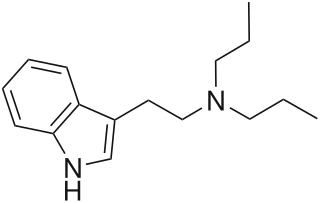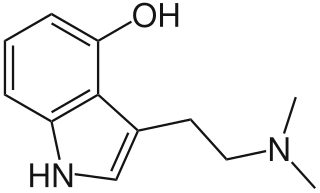
N,N-Dipropyltryptamine (DPT) is a psychedelic entheogen belonging to the tryptamine family. Use as a designer drug has been documented by law enforcement officials since as early as 1968. However, potential therapeutic use was not investigated until the 1970s. It is found either as a crystalline hydrochloride salt or as an oily or crystalline base. It has not been found to occur endogenously. It is a close structural homologue of dimethyltryptamine and diethyltryptamine.

4-Hydroxy-N,N-diisopropyltryptamine is a synthetic psychedelic drug. It is a higher homologue of psilocin, 4-HO-DET, and is a positional isomer of 4-HO-DPT and has a tryptamine molecular sub-structure.

Psilocin is a substituted tryptamine alkaloid and a serotonergic psychedelic substance. It is present in most psychedelic mushrooms together with its phosphorylated counterpart psilocybin. Psilocin is a Schedule I drug under the Convention on Psychotropic Substances. The mind-altering effects of psilocin are highly variable and subjective and resemble those of LSD and DMT.

Daptomycin, sold under the brand name Cubicin among others, is a lipopeptide antibiotic used in the treatment of systemic and life-threatening infections caused by Gram-positive organisms.

5-MeO-DALT or N,N-di allyl-5-methoxy tryptamine is a psychedelic tryptamine first synthesized by Alexander Shulgin.

4-HO-MiPT is a synthetic substituted aromatic compound and a lesser-known psychedelic tryptamine. It is thought to be a serotonergic psychedelic, similar to magic mushrooms, LSD and mescaline. Its molecular structure and pharmacological effects somewhat resemble those of the tryptamine psilocin, which is the primary psychoactive chemical in magic mushrooms.

N-Methyl-N-isopropyltryptamine (MiPT) is a psychedelic tryptamine, closely related to DMT, DiPT and Miprocin.

5-MeO-DPT, is a psychedelic and entheogenic designer drug.

Fumarase is an enzyme that catalyzes the reversible hydration/dehydration of fumarate to malate. Fumarase comes in two forms: mitochondrial and cytosolic. The mitochondrial isoenzyme is involved in the Krebs cycle and the cytosolic isoenzyme is involved in the metabolism of amino acids and fumarate. Subcellular localization is established by the presence of a signal sequence on the amino terminus in the mitochondrial form, while subcellular localization in the cytosolic form is established by the absence of the signal sequence found in the mitochondrial variety.

4-Hydroxy-N-methyl-N-propyltryptamine, commonly known as 4-HO-MPT or meprocin, is a psychedelic drug in the tryptamine class of chemical compounds and is a higher homologue of the naturally occurring substituted tryptamine psilocin as well as being the 4-hydroxyl analog of MPT.

Aeruginascin or N,N,N-trimethyl-4-phosphoryloxytryptamine is an indoleamine derivative which occurs naturally within the mushroom Inocybe aeruginascens and Pholiotina cyanopus. Aeruginascin is the N-trimethyl analogue of psilocybin. It is closely related to the frog skin toxin bufotenidine (5-HTQ), a potent 5-HT3 receptor agonist, but the aeruginascin metabolite 4-HO-TMT shows strong binding at the 5-HT2 receptors similar to psilocin. The first scientific literature about the pharmacological effects of aeruginascin is from a study published by Gartz in 1989. Across 23 analyzed cases of accidental hallucinogenic mushroom poisonings, people who had ingested the mushroom Inocybe aeruginascens reported only euphoric experiences. This is in contrast to the slight and in some cases extremely dysphoric experiences reported from the accidental ingestion of non aeruginascin containing mushrooms (containing solely psilocybin and psilocin).

4-HO-MPMI is a tryptamine derivative that is a psychedelic drug. It was developed by the team led by David Nichols from Purdue University in the late 1990s. This compound produces hallucinogen-appropriate responding in animal tests with a similar potency to the amphetamine-derived psychedelic DOI, and has two enantiomers, with only the (R)-enantiomer being active.

[S-]-UH-301 is a drug and research chemical widely used in scientific studies. It acts as a selective 5-HT1A receptor silent antagonist. It is structurally related to 8-OH-DPAT. UH-301 was found to produce a head-twitch response in mice which is usually typical of 5-HT2A agonist drugs, and has subsequently been used to investigate how 5-HT1A receptor activity modulates 5-HT2A receptors downstream.

Methylpropyltryptamine is a tryptamine. It is a homolog of methylethyltryptamine.

Hydrogen polyoxides are chemical compounds that consist only of hydrogen and oxygen atoms, are bonded exclusively by single bonds, and are acyclic. They can, therefore, be classed as hydrogen chalcogenides.

4-HO-McPT (4-hydroxy-N-methyl-N-cyclopropyltryptamine) is a psychedelic tryptamine derivative. It has serotonergic effects, and has reportedly been sold as a designer drug since around 2016, but was not definitively identified by forensic laboratories until 2018. It is illegal in Finland.

4-Acetyloxy-N,N-dipropyltryptamine is a tryptamine derivative. 4-AcO-DPT has been sold as a designer drug. It is an ester of 4-HO-DPT, a psychedelic tryptamine first synthesized by Alexander Shulgin. Anecdotal reports indicate that 4-AcO-DPT exerts psychoactive effects in humans, however, the pharmacology of 4-AcO-DPT has not been examined.

MALT is a lesser-known drug from the tryptamine family. It is a novel compound with very little history of human use. It is closely related to methylpropyltryptamine (MPT), as well as N-methyltryptamine. It has been sold online as a designer drug. Very little information on the pharmacology or toxicity of MALT is available.



















